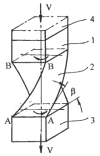Review: Modes and Processes of Severe Plastic Deformation (SPD)
- PMID: 29996494
- PMCID: PMC6073336
- DOI: 10.3390/ma11071175
Review: Modes and Processes of Severe Plastic Deformation (SPD)
Abstract
In this review, severe plastic deformation (SPD) is considered as a materials processing technology. The deformation mode is the principal characteristic differentiating SPD techniques from common forming operations. For large plastic strains, deformation mode depends on the distribution of strain rates between continuum slip lines and can be varied from pure shear to simple shear. A scalar, invariant, and dimensionless coefficient of deformation mode is introduced as a normalized speed of rigid rotation. On this basis, simple shear provides the optimal mode for structure modification and grain refinement, whereas pure shear is “ideal” for forming operations. Special experiments and SPD practice confirm this conclusion. Various techniques of SPD are classified and described in accordance with simple shear realization or approximation. It is shown that correct analyses of the processing mechanics and technological parameters are essential for the comparison of SPD techniques and the development of effective industrial technologies.
Keywords: SPD techniques; mode deformation; severe plastic deformation (SPD); simple shear and pure shear; structure modification.
Conflict of interest statement
The author declare no conflicts of interest.
Figures























References
-
- Kulhman-Wilsdorf D. Theory of plastic deformation-properties of low-energy dislocation structures. Mater. Sci. Eng. A. 1989;113:1–41. doi: 10.1016/0921-5093(89)90290-6. - DOI
-
- Hansen N. Cold deformation microstrustures. Mater. Sci. Technol. 1990;11:1039–1047. doi: 10.1179/mst.1990.6.11.1039. - DOI
-
- Bridgman P.W. Studies in Large Plastic Deformation and Fracture. McGraw-Hill; New York, NY, USA: 1952. p. 362.
-
- Valiev R.Z., Islamgaliev R.K., Aleksandrov I.V. Bulk nanostructured materials from severe plastic deformation. Prog. Mater. Sci. 2000;45:103–189. doi: 10.1016/S0079-6425(99)00007-9. - DOI
-
- Mayers M.A., Mishra M., Benson D.J. Mechanical properties of nanocrystalline materials. Prog. Mater. Sci. 2006;51:427–556. doi: 10.1016/j.pmatsci.2005.08.003. - DOI
Publication types
LinkOut - more resources
Full Text Sources
Other Literature Sources

